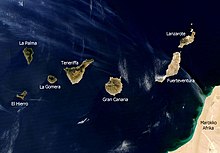Canary Islands - Simple English Wikipedia, the free encyclopedia
Canary Islands Canarias (Spanish) | |
|---|---|
| Anthem: Himno de Canarias "Anthem of the Canaries" | |
 Location of the Canary Islands relative to the Spanish mainland | |
| Coordinates: 28°N 16°W / 28°N 16°W | |
| Country | |
| Largest city | Las Palmas de Gran Canaria |
| Capital | Las Palmas de Gran Canaria and Santa Cruz de Tenerife[1] |
| Provinces | Las Palmas, and Santa Cruz de Tenerife |
| Government | |
| • President | Ángel Víctor Torres (PSC–PSOE) |
| Area | |
| • Total | 7,493 km2 (2,893 sq mi) |
| • Rank | 1.88% of Spain; ranked 13th |
| Population (2019)[2] | |
| • Total | 2,153,389 |
| • Rank | 8th |
| • Density | 290/km2 (740/sq mi) |
| • Percentage | 4.58% of Spain |
| Demonyms | Canarian canario/-a (Spanish) |
| Time zone | UTC (WET) |
| • Summer (DST) | UTC+1 (WEST) |
| ISO 3166 code |
|
| Most populated island | Tenerife[2] |
| Official language | Spanish |
| Statute of Autonomy | 7 November 2018 |
| Parliament | Canarian Parliament |
| Congress seats | 15 (of 350) |
| Senate seats | 14 (of 265) |
| HDI (2018) | 0.861[3] very high · 15th |
| Website | www |

The Canary Islands are an autonomous community of Spain located off the coast of Africa. Consisting of seven main islands and over 50 smaller islands and islets, this region has a volcanic origin which can be appreciated in every one of them, specially in Santa Cruz de Tenerife, where we can find El Teide. The autonomous community has two capital cities, of equal status: Santa Cruz de Tenerife and Las Palmas de Gran Canaria.
The seven islands are: La Palma, La Gomera, El Hierro, Tenerife, Gran Canaria, Lanzarote, and Fuerteventura. People from La Gomera have a whistle language that children there learn at school. Tenerife has the highest mountain in the Canary Islands and Spain too, the Teide. The Teide is actually a volcano, but it has not been active in more than 300 years.
The islands are popular with tourists because of their warm climate and nice beaches. The local farmers grow lots of exotic fruits including papayas and bananas.
It is believed that the first group of people who inhabited the islands were a group of Berber people named Guanches, original from North Africa, settling in the islands at some point in the first millennium BCE, with estimates ranging from around 1000 BCE to 200 BCE.
The islands were later conquered by the Castilians in the 15th century, bringing significant changes to the islands, including language, religion or customs. When the Castilians arrived in the Canary Islands in the 15th century, they encountered fierce resistance from the Guanches who sought to defend their land. However, the Guanches were ultimately overwhelmed by the superior military technology and tactics of the Spanish forces. The conquest led to the subjugation and displacement of the Guanches on the islands. The Guanches were gradually assimilated into Castilian society, resulting in the decline of their population and cultural heritage over time.
Castilian colonization led to economic growth as the Canary Islands became a hub for trade routes to America, which facilitated trade and commerce. New technologies and agricultural practices were also introduced, improving productivity and efficiency in farming, fishing, and other industries.
Spaniards brought with them architectural styles and construction techniques that influenced the built environment of the Canary Islands. This includes the construction of fortifications, churches, and colonial buildings that still stand today as part of the islands' cultural heritage. They also introduced new systems of governance and administration to the Canary Islands, integrating them into the Spanish Empire. This included the establishment of colonial institutions, legal systems, and administrative structures.
References[change | change source]
- ↑ "Ley Orgánica 1/2018, de 5 de noviembre, de reforma del Estatuto de Autonomía de Canarias". BOE (in Spanish). 6 November 2018. Archived from the original on 23 September 2019. Retrieved 23 September 2019.
- ↑ 2.0 2.1 "Real Decreto 743/2019, de 20 de diciembre, por el que se declaran oficiales las cifras de población resultantes de la revisión del Padrón municipal referidas al 1 de enero de 2019". BOE (in Spanish). 27 December 2019. Archived from the original on 20 February 2020. Retrieved 20 February 2020.
- ↑ "Sub-national HDI – Area Database – Global Data Lab". hdi.globaldatalab.org. Archived from the original on 23 September 2018. Retrieved 13 September 2018.
Other websites[change | change source]
 Media related to Canary Islands at Wikimedia Commons
Media related to Canary Islands at Wikimedia Commons Canary Islands travel guide from Wikivoyage
Canary Islands travel guide from Wikivoyage


 French
French Deutsch
Deutsch

